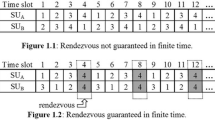Abstract
The purpose of cognitive radio (CR) technology is to improve spectrum utilization. In recent years, dynamic spectrum access (DSA) has become one of critical researches for achieving improved transmission performance in CR. A rendezvous algorithm facilitates a connection between a pair of secondary users (SUs) to achieve peer to peer transmission in CR environment. Most researchers have adopted the rendezvous degree and the time to rendezvous (TTR) as key factors to design rendezvous algorithms. However, the occurrence of a primary user (PU) can shield off the rendezvous even when both SUs occupy the same channel. A complete peer to peer transmission process in cognitive radio network (CRN) provides not only rendezvous for SUs but also channel access for data transmission under priority usage of PU. This paper proposes an algorithm to achieve shift-based channel hopping for continuous rendezvous (SCHCR) to guarantee that each SU can rendezvous continuously with its receiver within the upper bound of the expected TTR without a centralized control mechanism. This continuity property facilitates rendezvous, particularly when PUs exist. Based on the rendezvous algorithm, this paper further proposes a threshold controlled skip (TCS) scheme and two policies for the occurrence of PU to resolve channel contention and data transmission problems. Simulation results indicated that the proposed schemes achieve shorter rendezvous time, particularly when the load of PU is high, and facilitate superior transmission performance.














Similar content being viewed by others
References
Wang B, Liu KJR (2011) Advances in cognitive radio networks: a survey. IEEE J Sel Top Signal Process 5:5–23
Dhar S, Ray A, Bera R (2013) Cognitive vertical handover engine for vehicular communication. Peer-to-Peer Netw Appl 6(3):305–324
FCC (2003) Facilitating opportunities for flexible, efficient and reliable spectrum use employing cognitive radio technologies: Notice of proposed rule making and order, ET Docket No 03–222
Akyildiz IF, Lee WY, Vuran MC, Mohanty S (2006) NeXt generation/dynamic spectrum access/cognitive radio wireless networks: a survey. Comput Netw 50:2127–2159
Theis NC, Thomas RW, DaSilva LA (2011) Rendezvous for cognitive radios. IEEE Trans Mob Comput 10(2):216–227
Cormio C, Chowdhury KR (2010) Common control channel design for cognitive radio wireless ad hoc networks using adaptive frequency hopping. Ad Hoc Netw 8:430–438
Kim MR, Yoo SJ (2009) Distributed coordination protocol for common control channel selection in multichannel ad-hoc cognitive radio networks. Wireless and Mobile Computing, Networking and Communications (WIMOB), pp. 227–232
Cormio C, Chowdhury KR (2010) An adaptive multiple rendezvous control channel for Cognitive Radio wireless ad hoc networks. Pervasive Computing and Communications Workshops (PERCOM Workshops), pp. 346–351
Liu Q, Pang D, Hu G, Zhou X (2012) A neighbor cooperation framework for time-efficient asynchronous channel hopping rendezvous in cognitive radio networks. Dynamic Spectrum Access Networks (DYSPAN), pp. 529–539
Bian K, Park JM (2011) Asynchronous channel hopping for establishing rendezvous in cognitive radio networks. IEEE INFOCOM, pp. 236–240
Silvius MD, Ge F, Young A, MacKenzie AB, Bostian CW (2008) Smart radio: spectrum access for first responders. Proc. SPIE 6980, Wireless Sensing and Processing III, 698008, pp. 1–12. doi:10.1117/12.777678
Jia J, Zhang Q (2013) Rendezvous protocols based on message passing in cognitive radio networks. IEEE Trans Wirel Commun 12(11):5594–5606
Yu L, Liu H, Leung YW, Chu X, Lin Z (2013) Multiple radios for effective rendezvous in cognitive radio networks. IEEE Int Conf Commun, ICC, p. 2857–2862
Reguera V, Guerra EO, Souza RD, Fernandez E, Brante G (2014) Short channel hopping sequence approach to rendezvous for cognitive networks. IEEE Commun Lett 18(2):289–292
DaSilva L, Guerreiro I (2008) Sequence based rendezvous for dynamic spectrum access. IEEE Int’l Symp New Front Dyn Spectr Access Netw pp. 1–7
Wang YC (2011) The analysis of shift sequence based channel selection in cognitive radio network. Master Thesis, National Central University
IEEE 802.22 Working Group on Wireless Regional Area Networks. http://www.ieee802.org/22/
ECMA Std. 392 (2009) MAC and PHY for Operation in TV White Space
Acknowledgments
This research work was supported in part by the grants from the National Science Council (NSC) (grant numbers: NSC 98-2221-E-008-063, NSC 99-2218-E-159-001, NSC 100-2221-E-008-097, and NSC 101-2221-E-159-026), Taiwan, ROC.
Author information
Authors and Affiliations
Corresponding author
Rights and permissions
About this article
Cite this article
Chen, YW., Liao, PY. & Wang, YC. A channel-hopping scheme for continuous rendezvous and data delivery in cognitive radio network. Peer-to-Peer Netw. Appl. 9, 16–27 (2016). https://doi.org/10.1007/s12083-014-0308-9
Received:
Accepted:
Published:
Issue Date:
DOI: https://doi.org/10.1007/s12083-014-0308-9




